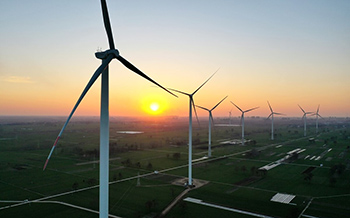A wind turbine is a power machine that converts wind energy into mechanical work. Generally speaking, it is a thermal energy generator that uses the sun's micro-heat source and the atmosphere as the working medium. Wind turbines use natural energy, which is much better than diesel power generation. But if it is used in an emergency, it is not as good as a diesel generator. Wind power cannot be regarded as a backup power source, but it can be used for a long time. Wind turbines are composed of nacelles, rotor blades, shafts, gearboxes and other components. Today we will introduce the role of these components one by one.
Components of wind turbine
Nacelle: The nacelle contains the key equipment of the wind turbine, including the gearbox and generator. Maintenance personnel can access the nacelle through the wind turbine tower. At the left end of the nacelle is the rotor of the wind turbine, i.e. the rotor blades and the shaft.
Rotor blade: The blade is a unit that absorbs wind energy and is used to convert the kinetic energy of the air into the mechanical energy of the impeller rotation. It captures the wind and transmits it to the rotor shaft. Each rotor blade of the 600kW wind turbine measures approximately 20 meters in length and is designed to be the wing of an aircraft.
Shaft: The shaft of the rotor is attached to the low speed shaft of the wind turbine.
Low-speed shaft: The low-speed shaft of the wind turbine connects the rotor shaft and the gearbox. The rotor speed of a 600-kilowatt wind turbine is rather slow, about 19 to 30 revolutions per minute. There is a hydraulic system conduit on the shaft that stimulates the operation of the pneumatic brake.
Gearbox: The left side of the gearbox is the low-speed shaft, which can increase the speed of the high-speed shaft to 50 times that of the low-speed shaft.
High-speed shaft and its mechanical brake: The high-speed shaft runs at 1500 rpm to drive the generator. It is equipped with an emergency mechanical brake for use in the event of a pneumatic brake failure or wind turbine repairs.
Generator: It is commonly known as an induction motor or asynchronous generator. The maximum power output of wind turbines is usually 500-1500 kW.
Yaw device: The nacelle is rotated by the motor so that the rotor faces the wind. The yaw device is operated by an electronic controller, which can sense the wind direction through the wind vane. Typically, wind turbines only deflect a few degrees at a time when the wind changes direction.
Electronic controller: It includes a computer that continuously monitors the status of the wind turbine and controls the yaw device. To prevent any failure (like a gearbox or generator overheating), the controller can automatically stop the wind turbine from spinning and call the wind turbine operator via a phone modem.
Hydraulic system: It is used to reset the pneumatic brake of the wind turbine.
Cooling element: It includes a fan that cools the generator. In addition, it includes an oil cooling element for cooling the oil in the gearbox. Some wind turbines have water-cooled generators.
Tower: The wind turbine tower carries the nacelle and rotor. Usually, tall towers have an advantage because the higher the ground, the faster the wind speed. The tower height of the 600 kW wind turbine is 40 to 60 meters. The tower of the wind turbine can be a tubular tower or a lattice tower. Tubular towers are safer for maintenance personnel as they can reach the top of the tower via an internal ladder. The advantage of lattice towers is that they are less expensive.
Anemometer and wind vane: They are used to measure wind speed and direction.
Rudder: A small wind turbine (generally 10KW and below), which is common in the wind direction of the horizontal axis. It is located behind and connected to the rotating body.
To conclude, we introduce the structure of wind turbines to you. From this passage, you can know how each part of a wind turbine works clearly. The popularity and development of wind turbines are extremely rapid. The effect and function of wind turbines are also huge. We believe that you must learn a lot.
